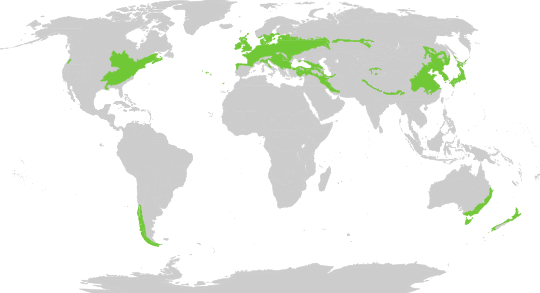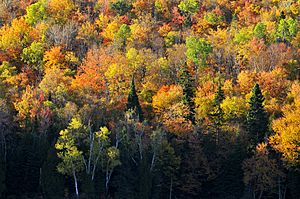Temperate broadleaf and mixed forests facts for kids
Temperate broadleaf and mixed forests are special places on Earth. They are a type of habitat found in areas with a temperate climate. These forests get their name because they have two main types of trees: broadleaf trees and conifers. Broadleaf trees have wide, flat leaves, like oaks and maples. Conifers have needles and cones, like pines and spruces.
These amazing forests are especially rich and unique in places like central China and eastern North America. You can also find them in the Caucasus mountains, the Himalayas, parts of Southern Europe, Australasia, southwestern South America, and the Russian Far East.
Contents
Exploring the Forest Layers
Imagine walking into one of these forests! You would see different layers of plants, almost like floors in a building. There are usually four main layers:
- The very top layer is called the canopy. This is where the tallest, most grown-up trees live. They can be very high, sometimes as tall as a 20-story building!
- Below the canopy is the understory. This layer is a bit shorter, usually about 9 to 15 meters (30 to 50 feet) tall. It has three parts:
- The sub-canopy is the highest part of the understory. It has smaller mature trees and young trees waiting for a spot in the main canopy.
- Next is the shrub layer. This layer is made up of shorter, woody plants that grow close to the ground.
- The lowest layer is the ground cover or herbaceous layer. This is where you'll find small plants, ferns, and wildflowers. It's often the most diverse layer, meaning it has the most different kinds of plants!
Meet the Trees of the Forest
In the northern parts of the world, you'll often see certain broadleaf trees dominating these forests. Look for mighty oaks (Quercus), tall beeches (Fagus), colorful maples (Acer), and graceful birches (Betula).
The "mixed forest" part of the name comes from the conifers that also grow here. Common conifers include towering pines (Pinus), firs (Abies), and spruces (Picea). Sometimes, these needle-leaved trees are even more common than the broadleaf trees!
In the Southern Hemisphere, you'll find unique trees like Nothofagus and Eucalyptus. Many conifers there, like those from the Araucariaceae and Podocarpaceae families, also mix with broadleaf trees.
The Climate These Forests Love
Temperate broadleaf and mixed forests grow in areas that have clear warm and cool seasons. This means the temperature changes quite a bit throughout the year. The average temperature is usually between 3 and 23 degrees Celsius (37 to 73 degrees Fahrenheit).
These forests prefer warm and rainy climates. Sometimes, they might have a dry season. For example, East Asia often has a dry winter, and some areas near the Mediterranean climate have dry summers. Other places, like central eastern North America, get rain pretty evenly all year.
Annual rainfall is usually more than 600 millimeters (24 inches). It can even be over 1500 millimeters (59 inches) in some places. However, it can be as low as 300 millimeters (12 inches) in parts of the Middle East or as high as 6000 millimeters (236 inches) in the mountains of New Zealand. Even in places with very cold winters, like Ussuriland in Asia, you can find these tough forests!
The climate is usually humid for most of the year. These forests are often found in humid subtropical climate zones, where summers are not too hot and winters are mild. They also appear in the southern parts of humid continental climate zones, which are south of the very cold tundra and subarctic taiga regions.
Forest Regions Around the World
These forests are found in many different parts of the world, each with its own special mix of trees and plants. Here are just a few examples:
Forests in Australasia
Australasia includes places like Australia and New Zealand. Here, you'll find unique temperate broadleaf and mixed forests with trees found nowhere else.
- Tasmanian temperate rain forests in Australia
- New Zealand temperate forests in New Zealand
Forests in Eurasia
Eurasia is a huge continent, combining Europe and Asia. It has many different temperate broadleaf and mixed forest regions.
- In Asia:
- Eastern Himalayan broadleaf forests in Bhutan, India, Nepal
- Caspian Hyrcanian mixed forests in Iran, Azerbaijan
- Changbai Mountains mixed forests in China, North Korea
- In Europe:
- Atlantic mixed forests in Denmark, France, Belgium, Germany, Netherlands
- Balkan mixed forests in Bulgaria, Greece, North Macedonia, Romania, Serbia, Turkey
- Celtic broadleaf forests in the United Kingdom, Ireland
Forests in the Americas
Both North and South America have their own types of temperate broadleaf and mixed forests.
- In North America:
- Appalachian mixed mesophytic forests in the United States
- Eastern forest-boreal transition in Canada, United States
- Mississippi Alluvial Plain forests in the United States
- In South America:
See also
 In Spanish: Bosques templados de frondosas y mixtos para niños
In Spanish: Bosques templados de frondosas y mixtos para niños
- Mixed coniferous forest
- Temperate deciduous forest
- Trees of the world



